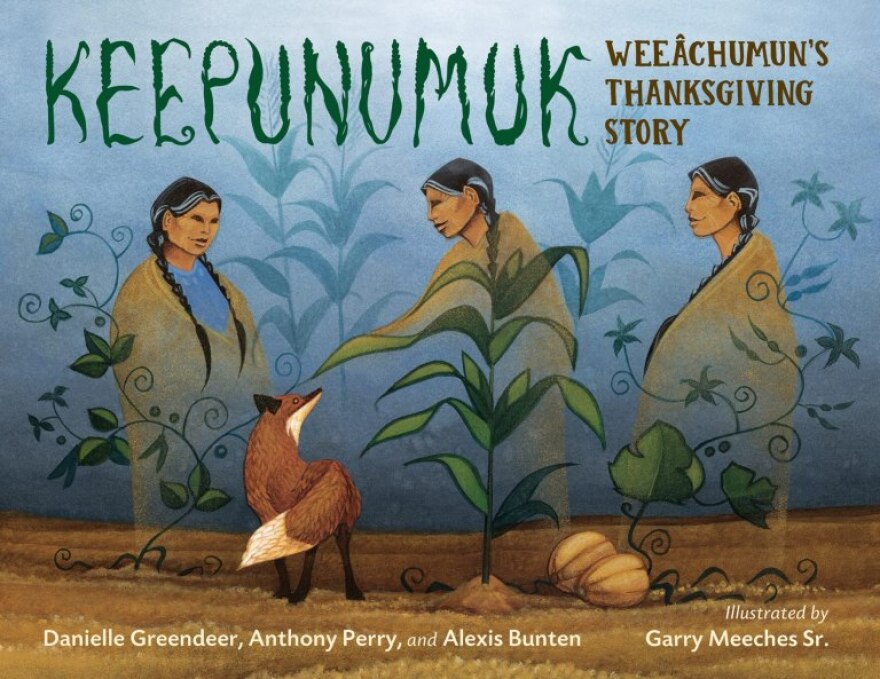When Mashpee Wampanoag author Danielle Greendeer started looking around for children’s books on Thanksgiving to share with her three young kids,she found a void. So, she and two other Native American authors and a native illustrator decided to fill it:
"So the story of Keepunumuk, Weeâchumun’s Thanksgiving Story, is historical fiction. It is based on real historical documents, myself and the two co-authors, we did a lot of research, and it was great to have an all-native team. Everybody was really on the same page, but what we shared was just a desire to figure out a way first and foremost to tell a real, authentic Native American version of Thanksgiving to children."
Danielle and her co-authors wanted to cover important themes like colonization and native observance of the fourth Thursday in November as a National Day of Mourning, and they didn’t want the typical Indians versus Pilgrims narrative. So instead, they brought in the three sisters: corn, beans, and squash.
"We figured that telling it from the perspective of the plants and the animals was also natural because the plants and the animals were there and they have genetic memory and they would have been the silent watchers and the listeners of when all of these interactions were happening with the newcomers and the natives. So we thought that was kind of special and something that wasn't paid attention to."
The book opens with a Wampanoag grandmother telling the story of the time Weeâchumun or corn asked the children’s Wampoanag ancestors to help the Pilgrims:
"Corn is non-discriminatory. Of course, she is a plant being and her only job is to nourish and feed people, which she has done all over the world," Danielle said.
"She wouldn't have cared about color. She wouldn't have cared about where these people are from. She wouldn't have cared about territory. She saw that these newcomers were hungry. She also needs help to grow. You know, she needs the help of human hands. So it was almost like a mutually beneficial relationship. If she could somehow figure out a way to teach them how to grow her properly, then she would survive. And then they would survive."
In the book, Weeâchumun does this by asking the First Peoples to help the newcomers through a series of dreams. Danielle says she and her co-authors spent a lot of time researching and writing this part of the story:
"So in actual history, the natives did not first approach the English right away, and there were many attempts to kind of ward them off that were not that successful," Danielle explained.
"So you could assume or just wonder, why would they help them? Why would these native people help the English survive, especially when they just endured a plague? Everybody was killed off. And especially when, you know, these people are coming here with women and children and it looks like they're trying to stay. So we introduced the idea of Weeâchumun sending dreams. So that is to explain the motive behind why the leader, Ousamequin would even approach them, why Squanto would even show them how to grow corn. And it was because Corn as a spirit being saw a need, she had compassion in her heart for these other human beings."
Dreams are important in Native American lore, Danielle told me, as is storytelling. Both have the capacity to expand our understanding beyond our own experience. And this has been a key goal of hers in sharing this Wampanoag version of Thanksgiving.
"The book has been so well received all around the country. I think everybody knew that there’s a huge discrepancy between a meal that was enjoyed and shared 400 years ago then fast forward to present day, people know with the discussion around the mascots, with the discussion around the pipelines going through reservations, or just knowing that you know some tribes in reservations don’t have running water or electricity," Danielle said.
She added, "I mean, I think everybody just wanted a little bit of Truth, and also wanted to transform Thanksgiving. It felt like a little bit stale for a while, people didn't know what to do, but they knew that there was something not right. So the book is really filling a gap."
Keepunumuk means a time of harvest — a celebration that cultures all over the world share — with food as the centerpiece.








